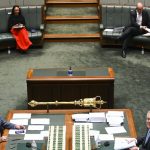The branch-stacking scandal: How the fourth estate safeguards Australian democracy

On 14 June 2020, exposés published by 60 Minutes and The Age alerted the public to serious dysfunction within the Australian Labor Party (ALP).
The figure at the centre of the scandal was Adem Somyurek; an influential ALP powerbroker and Cabinet Minister in the Andrews Government. Candid footage and audio recordings displayed by 60 Minutes and The Age exposed Somyurek’s deplorable behaviour; revealing his unbridled contempt for proper procedure and his political rivals within the party.
More importantly, the recordings brought to light Somyurek’s unethical scheme to gain control over the ALP. The recordings revealed that Somyurek had accumulated his extraordinary power through large-scale branch-stacking, forgery and misappropriation.

Photographs of a corrupt exchange between Somyurek and Ministerial staffer Nick McLennan obtained by 60 Minutes and The Age.
Branch-stacking involves recruiting people (some of them fictitious) to join a party branch for the purpose of securing majority control of that branch’s membership. As with Somyurek’s operation, branch-stacking typically involves enlisting members from particular ethnic groups to fill the ranks of a party branch.
Though not illegal, this practice is fraudulent in nature and undermines the process by which branches are involved in democratic decision-making forums to determine party policy.
The exposure of Somyurek’s misconduct by investigative journalists demonstrates that the Fourth Estate continues to play a vital role safeguarding democracy in Australia. The Fourth Estate is a concept which holds that the news-media have a responsibility to act as guardians of the public interest by scrutinising the activities of those in power.
By presenting evidence of branch-stacking to the public, attention was drawn to a vulnerability in our political system; a solution which has eluded Australian political parties for as long as it has been exploited. It was the public and political backlash generated by the revelations which motivated Premier Andrews to sack Somyurek from the Ministry, refer the evidence to the authorities and, most importantly, request an inquiry to address branch-stacking.
60 Minutes and The Age thus fulfilled a Fourth Estate function by using their informational power to hold the Andrews Government and the ALP accountable. In doing so, these news-outlets effectively acted as an additional layer of defence against corruption; exposing malfeasance which had evaded detection by the state’s anti-corruption watchdog.
Affairs such as the branch-stacking scandal serve to remind us of the important role journalists have played exposing corruption throughout Australian history. The manner in which evidence of branch-stacking was uncovered by 60 Minutes and The Age bears striking resemblance to emblematic pieces of investigative journalism from the 1980s that alerted the public to malfeasances which had avoided the attention of authorities.
In March 1980, journalist David Richards used identical techniques to gather evidence against the Federated Ship Painters and Dockers Union (FSPDU). Concealed in a shopping container on the Melbourne waterfront, Richards and his cameraman secretly photographed the different stages of a union ghosting scheme.
The photographs featured in one of a series of articles published in The Bulletin revealed violence, fraud and other criminal activities orchestrated by the FSPDU.
Other evidence obtained by Richards, including leaked documents and whistle-blowers, also featured in the articles. A significant aspect of these articles was that they illuminated the complacency of police and governments towards the FSPDUs criminal activities, many of which had been known to authorities since the final report of the Sweeney Royal Commission delivered in April 1976.
The articles essentially contended that police and government had failed to uphold the rule of law by neglecting to act against the union. Richards’ articles prompted the federal government to establish the Costigan Royal Commission; a four-year exploratory inquiry which made numerous recommendations to address organised crime and corruption in Australia.

Surveillance photographs taken by David Richards and a cameraman of an FSPDU foreman collecting then distributing pack packets to idle workers; a fraudulent practice known as ghosting.
The branch-stacking scandal also shares similarities with the Age tapes affair. In February 1984, investigative journalists at The Age were presented with tapes and transcripts produced by a police telephone tapping operation.
Though legally inadmissible for prosecution, the police tapes contained evidence of serious impropriety. On the tapes were recorded conversations between an ill-reputed solicitor and his various friends and associates, which included an organised crime figure, police and a High Court Judge.
Within the conversations, the solicitor and the Judge candidly conspired on matters involving nepotism, collusion and adultery. The articles claim that a network of influence had been uncovered; a corrupt relationship between organised crime interests and a member of the nation’s highest judicial institution.
The judicial figure at the centre of the scandal was soon revealed to be Justice Lionel Murphy. Formerly a controversial senior minister in the Whitlam Government (1972-1975), Murphy was appointed to the High Court bench in February 1975, nine months before Whitlam’s dismissal by the Governor-General Sir John Kerr.
The scandal prompted others to come forward with allegations that Murphy had attempted to exert his influence to pervert the course of justice. Over the two-years, Murphy was subject to an array of trials and inquiries to determine whether or not he had committed an offence or ought to be removed from the judiciary for misbehaviour.
Given the consensus of the 1986 Parliamentary Commission of Inquiry, that it was for Parliament to interpret whether Murphy’s behaviour amounted to misconduct, it is possible that, had he not succumbed to cancer, Parliament may have resolved to removed Murphy from the bench.
Had the police tapes not found their way to journalists, Murphy’s misconduct would never have been exposed to public appraisal.

Justice Lionel Murphy; the High Court Judge at the centre of the 1984 Age tapes scandal.
These scandals ultimately demonstrate that the Fourth Estate forms an important part of Australia’s robust democratic political system. The news-media are essential to keeping citizens informed and holding those in power accountable to the public whom they serve.
Throughout history, investigative journalists have proved time and again that a vigilant Fourth Estate reinforces the function of law enforcement and anti-corruption bodies; scrutinising the conduct of those entrusted with public power and raising the alarm when malfeasance is detected.
Without this adjunct layer of defence against corruption, the preservation of democratic accountability is weakened. At a time when the public’s trust in politicians and government is at an all-time low, conserving the integrity of our political institutions is paramount.
Liam Lander is a PhD candidate in politics at Charles Sturt University. His upcoming thesis explores how scandals and corruption impacted Australian politics during the 1970s and 1980s. Liam was instrumental in prompting the recent declassification of the 1986 Parliamentary Commission of Inquiry documents relating to conduct of Justice Lionel Murphy.












